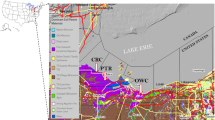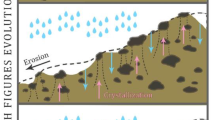Abstract
During the extreme precipitation event of 15th–17th June 2013 in Garhwal Himalaya, glacial lake outburst flooding accompanied by numerous landslides and flash flood events caused widespread death and destruction. Many hill slopes and steep river banks had developed fractures and fissures indicative of landslides and one such scarp was observed at Kunjethi (Kalimath) village on satellite images during routine analysis. Rainfall threshold analysis for years 2012, 2013, 2014 and 2015 has confirmed that it was the main triggering factor which happened due to extreme precipitation in June 2013 leading to scarp development and initiation of landslide. In order to characterize the landslide and get subsurface information, two highly cost-effective and fast non-invasive geophysical techniques, electrical resistivity tomography (ERT) and ground penetrating radar (GPR), were used. Four ERT profiles and one GPR radargram profile were used to determine the approximate depth to slip surface, which is inferred around 15–19 m. Integration of satellite remote sensing, geophysical studies and field observations have been used to demarcate the maximum possible slide zone. This study reiterates that earth observation tools in integration with faster, non-invasive and cost-effective geophysical techniques can establish the slip surface, which is an essential information required for landslide hazard mitigation measures.










Similar content being viewed by others
References
Asprion U, Reicherter K, Meschede M (1997) The ground penetrating radar and its application for the detection of tectonic structures: an example from the Freudenstädter Graben (Black Forest southwest Germany). Annual reports and communications of the Upper Rhine geological Association New Series, vol 79, pp 111–124
Bhattacharjee S, Champati Ray PK, Chattoraj SL, Dhara M (2017) Precipitation intensity-duration based threshold analysis for initiation of landslides in upper Alaknanda Valley. Int J Environ Chem Ecol Geol Geophys Eng 11(2):105–109
Bichler A, Bobrowsky P, Best M, Douma M, Hunter J, Calvert T, Burns R (2004) Three-dimensional mapping of a landslide using a multi-geophysical approach: the Quesnel Forks landslide. Landslides 1:29–40
Binley A, Kemna A (2005) DC resistivity and induced polarization methods. In: Yuram R, Hubbard S (eds) Hydrogeophysics. Water and Science Technology Library 50. Springer, New York, pp 129–156
Bist KS, Sinha AK (1980) Some observations on the geological and structural setup of Okhimath area in Garhwal Himalaya; a preliminary report. Himalayan Geol 10:467–475
Bogoslovsky VA, Ogilvy AA (1977) Geophysical methods for the investigation of landslides. Geophysics 42:562–571
Bristow CS, Jol HM (2003) Ground penetrating radar: applications in sediments. Geol Soc Lond Spec Publ 211:338
Castellanos Abella EA, Van Westen CJ (2008) Qualitative landslide susceptibility assessment by multicriteria analysis: a case study from San Antonio del Sur Guantánamo Cuba. Geomorphology 94:453–466
Champati ray PK, Chattoraj SL, Chand DS, Kannaujiya S (2013) Aftermath of Uttarakhand disaster 2013: an appraisal on risk assessment and remedial measures for Yamunotri shrine using satellite image interpretation. Indian Landslides 6(2):61–70
Champati ray PK, Chattoraj SL, Kannaujiya S, Bisht MPS, Pandey K, Goswami A (2015) Kedarnath disaster 2013: causes and consequences using remote sensing inputs. Nat Hazards 81(1):227–243. https://doi.org/10.1007/s11069-015-2076-0
Chattoraj SL (2017) Debris flow modelling and risk assessment of selected landslides from Uttarakhand-case studies using earth observation data. In: Santra A, Santra S (eds) Remote sensing techniques and GIS applications in earth and environmental studies (chapter-6). IGI Publications, Hershey, pp 111–121
Chattoraj SL, Champati ray PK (2015) Simulation and modelling of debris flows using satellite derived data: a case study from Kedarnath area. Int J Geomat Geosci 6(2):1498–1511
Chattoraj SL, Champati Ray PK, Kannaujiya S (2017) Simulation outputs of major debris flows in Garhwal Himalaya: a geotechnical modelling approach for hazard mitigation. In: Navalgund RR, Senthil Kumar A, Nandy S (eds) Remote sensing of northwest himalayan ecosystems. Springer, New Delhi. https://doi.org/10.4018/978-1-5225-1814-3.ch006
Cruden DM (1991) A simple definition of a landslide Bulletin International Association for. Eng Geol 43:27–29
Dobhal DP, Gupta AK, Metha M, Khandelwal DD (2013) Kedarnath disaster: facts and plausible causes. Curr Sci 105(2):171–174
Friedel S, Thielen A, Springman SM (2006) Investigation of a slope endangered by rainfall-induced landslides using 3D resistivity tomography and geotechnical testing. J Appl Geophys 60(2):100–114
Godio A, Strobbia C, De Bacco G (2006) Geophysical characterisation of a rockslide in an alpine region. Eng Geol 83:273–286
Hack R (2000) Geophysics for slope stability. Surv Geophys 21:423–448
Hunt RE (1984) Geotechnical engineering investigation manual. McGraw-Hill, New York, pp 665–784
Jongmans D, Garambois S (2007) Geophysical investigation 500 of landslides: a review. Bulletin de la Société géologique de France 178(2):101–112
Kuthari S (2007) Establishing precipitation thresholds for landslide initiation along with slope characterisation using GIS-based modeling. M.Sc. dissertation ITC Enschede, The Netherlands
Lapenna V, Lorenzo P, Perrone A, Piscitelli S, Rizzo E, Sdao F (2005) 2D electrical resistivity imaging of some complex landslides in Lucanian Apennine chain southern Italy. Geophysics 70(3):B11–B18
Loke MH, Barker RD (1996) Rapid least-squares inversion of apparent resistivity pseudo sections using a quasi-Newton method. Geophys Prospect 44:131–152
Mathew J, Babu G, Kundu S, Kumar VK, Pant CC (2013) Integrating intensity-duration based rainfall threshold and antecedent rainfall-based probability estimate towards generating early warning for rainfall-induced landslides in parts of Garhwal Himalaya, India. Springer, Berlin
McGuffey V, Modeer J, Victor A, Turner AK (1996) Subsurface exploration in landslides: investigation and mitigation. Special Report National Academy Press Washington DC, pp 231–277
Meric O, Garambois S, Jongmans D, Wathelet M, Chatelain J, Vengeon J (2005) Application of geophysical methods for the investigation of the large gravitational mass movement of sechilienne france. Can Geotech J 42:1105–1115
Perrone A, Zeni G, Piscitelli S, Pepe A, Loperte A, Lapenna V, Lanari R (2006) Joint analysis of SAR interferometry and electrical resistivity tomography surveys for investigating ground deformation: the case-study of Satriano di Lucania (Potenza Italy). Eng Geol 88:260–273
Petley DN (2012) Global patterns of loss of life from landslides. Geology 40(10):927–930
Reicherter K, Reiss S (2001a) The Carboneras Fault Zone (southeastern Spain) revisited with Ground Penetrating Radar—Quaternary structural styles from high-resolution images. Geology en Mijnbow Netherlands J Earth Sci 80:11–20
Reicherter K, Reiss S (2001b) Active faults in the Cubillas reservoir area mapped by 3D ground penetrating radar imaging (northeastern Granada Basin southern Spain) Zentralblatt. Geol Paleontol 1:167–179
Reiss S, Reicherter K, Reuther CD (2003) Visualization and characterization of active normal faults and associated sedimentary structures by high-resolution ground penetrating radar (GPR) In: Bristow CS, Jol HM (eds) Ground penetrating radar in sediments, vol 211. Geological Society London Special Publication, pp 247–255
Sah MP, Bisht KS (1998) Catastrophic mass movement of August 1998 in Okhimath area Garhwal Himalaya In: Proceeding of international workshop cum training programme on landslide hazard and risk assessment and damage control for sustainable development New Delhi, pp 259–282
Sass O, Bell R, Glade T (2008) Comparison of GPR 2D-resistivity and traditional techniques for the subsurface exploration of the Öschingen landslide Swabian Alb (Germany). Geomorphology 93(1–2):89–103
Telford WM, Geldart LP, Sheriff RE (1990) Applied geophysics. Cambridge University Press, Cambridge, p 770
Valdiya KS, Paul SK, Chandra T, Bhakuni SS, Upadhyay RC (1999) Tectonic and lithological characterization of Himadri (Great Himalaya) between Kali and Yamuna rivers central Himalaya. Himal Geol 20:1–17
Acknowledgements
Facilities provided at Indian Institute of Remote Sensing, ISRO, Dehradun, are gratefully acknowledged. Study was supported under Disaster Management Support Programme of ISRO. Special thanks to Director, IIRS, for constant encouragement and support.
Author information
Authors and Affiliations
Corresponding author
Additional information
Publisher's Note
Springer Nature remains neutral with regard to jurisdictional claims in published maps and institutional affiliations.
Rights and permissions
About this article
Cite this article
Kannaujiya, S., Chattoraj, S.L., Jayalath, D. et al. Integration of satellite remote sensing and geophysical techniques (electrical resistivity tomography and ground penetrating radar) for landslide characterization at Kunjethi (Kalimath), Garhwal Himalaya, India. Nat Hazards 97, 1191–1208 (2019). https://doi.org/10.1007/s11069-019-03695-0
Received:
Accepted:
Published:
Issue Date:
DOI: https://doi.org/10.1007/s11069-019-03695-0




